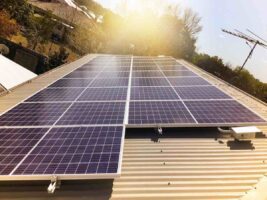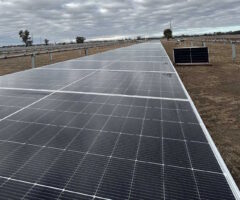AGL Energy has for the first time revealed some of the details of its new energy strategy, revealing plans to install more than 400MW of solar PV on the rooftops of its customers over the next five years.
![]() This is part of ambitious growth plans for the New Energy division, headed by Marc England, which includes a revenue target of $400 million by 2020, and a “break even” year on profits in 2018.
This is part of ambitious growth plans for the New Energy division, headed by Marc England, which includes a revenue target of $400 million by 2020, and a “break even” year on profits in 2018.
The division, which is to focus on new technologies such as solar, storage, electric vehicles and smart technologies for home energy management, is expected to lose $45 million a year as it builds its team to 200 or more.
AGL managing director Andrew Vesey, who hosted the investment day at the conclusion of his first 90 days in the role, has challenged the new energy division to be the biggest competitor to AGL’s existing business – which includes the largest coal generation fleet in the country, extensive gas interests, and a 4 million retail base.
But it is not clear exactly to what extent Vesey is pushing new energy with his foot to the floor. In the absence of any transcript or recording of the presentations, we have to make some guesses. But some of the slides in the presentation are revealing.
The first is this one above, which includes forecasts on the uptake of solar PV in Australia – from the high and low cases included in the 2014 National Electricity Forecasts from the Australian Market Operator, to AGL’s more modest forecast.
Either way, the penetration of rooftop solar will be the major swing factor in the future of Australia’s energy markets over the next decade or two.
AGL accepts that it will at least double in the next 15 years, but others, including rival Origin Energy, grid operators in WA, and analysts such as BNEF, forecast a much higher penetration than even the NEFR high uptake. Some say rooftop solar will be on every available household in the country by 2030.
Here’s perhaps why, though, AGL Energy may be more conservative. It’s a matter of self preservation. This next graph shows there is clearly enough room for more solar in the market, but it argues that under current business models, no more than half the market can be addressed.
That is possibly why AGL Energy has developed what might be described as a “hold and grow” corporate strategy – hold the profits of its massive and recent investments in coal fired generation as long as it can, and pursue rapid growth in its new energy division, that will be the major centre of growth in coming years.
It may also explain why AGL Energy is not yet ready to follow in the footsteps of its international rivals – either in implementing strategy or corporate rhetoric – about the future of fossil fuel generation.
Germany’s E.ON has already decided to split its assets in two – saying that centralized fossil fuel generation and a strategy to pursue solar, storage, electric vehicles and micro grids are incompatible.
In the US, the largest private generator NRG is pursuing a similar strategy in new energy, and while it has not yet talked of a split, it concedes that centralized generation has no long term future.
AGL despite operating as the biggest utility in the market with a level of solar penetration at the household level – far superior to that in the US, or even Germany – appears convinced that it can manage both.
As we reported last week, AGL Energy has been crunching the numbers on a split, but has clearly decided now is not the time to do so. Given that AGL Energy has such a paltry share of the rooftop solar market, that may be wise. Maybe, if it meets its 2020 target for 400MW of solar installs, it can reconsider the idea.
AGL Energy has recently said that it will build no new coal fired generators (a statement of the obvious) and committed to “phasing out” coal generation, but only by the previously advertised use by dates of its generators. It is clearly not quite ready to abandon the coal assets it bought in the last four years for more than $4 billion. Time will tell if it is right.
In the meantime, AGL hopes to use its brand and its balance sheet to fend off potential rivals in the home energy business – and intends to build alliances with those that may pose a threat.
The future focus on distributed generation is unavoidable. AGL makes that much clear, given the falling cost of distributed energy (both solar and storage), the need to reduce emissions, the proliferation of data (smart energy systems), and the inevitable electrification of vehicles. And the new demands and expectations of consumers.
It is pushing for demand based tariffs for distributed energy, which is a change from its push to time of use tariffs. It says this will help incentivise the uptake of battery storage.
And it concords with the views of other experts such as RMI in the US, the Australian PV Institute, and even the Grattan Institute, which managed to bury its policy recommendations beneath a whole lot of nonsense about the cost of past and discontinued subsidies.
AGL Energy also confirmed it will sell assets, including its 50 per cent stake in the 420MW Macarthur wind farm, Australia’s largest, as we reported last month.











